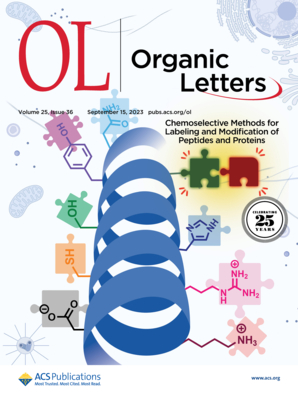两种阳离子反芳香族游离碱衍生物
IF 5
1区 化学
Q1 CHEMISTRY, ORGANIC
引用次数: 0
摘要
游离基抗芳卟啉类化合物的合成仍然是一项具有挑战性的任务。本文首次利用β环苯环抑制副反应的策略,制备了BC(H2)+(含两个NH基团,呈轻微鞍形)和BC(H4)3+(含四个NH基团,呈严重畸变鞍形)两个阳离子自由碱反芳香剂。BC(H2)+和BC(H4)3+的反芳性得到了晶体学分析、光谱证据和理论计算的有力支持。本文章由计算机程序翻译,如有差异,请以英文原文为准。


Two Cationic Antiaromatic Free-Base Corroles
The synthesis of free-base antiaromatic porphyrinoids remains a challenging task. Herein we report the first preparation of two cationic free-base antiaromatic corroles, BC(H2)+ (containing two NH moieties, slightly saddle-shaped) and BC(H4)3+ (containing four NH moieties, severely distorted saddle-shaped), utilizing a strategy of β-annulated benzene rings to suppress side reactions. The antiaromatic character of BC(H2)+ and BC(H4)3+ is robustly supported by crystallographic analysis, spectroscopic evidence, and theoretical calculations.
求助全文
通过发布文献求助,成功后即可免费获取论文全文。
去求助
来源期刊

Organic Letters
化学-有机化学
CiteScore
9.30
自引率
11.50%
发文量
1607
审稿时长
1.5 months
期刊介绍:
Organic Letters invites original reports of fundamental research in all branches of the theory and practice of organic, physical organic, organometallic,medicinal, and bioorganic chemistry. Organic Letters provides rapid disclosure of the key elements of significant studies that are of interest to a large portion of the organic community. In selecting manuscripts for publication, the Editors place emphasis on the originality, quality and wide interest of the work. Authors should provide enough background information to place the new disclosure in context and to justify the rapid publication format. Back-to-back Letters will be considered. Full details should be reserved for an Article, which should appear in due course.
 求助内容:
求助内容: 应助结果提醒方式:
应助结果提醒方式:


